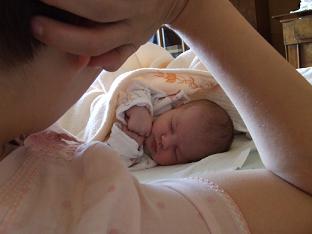 If your baby or toddler is having trouble sleeping through the night, the first thing you should know is… you’re not alone!
If your baby or toddler is having trouble sleeping through the night, the first thing you should know is… you’re not alone!
Studies show that up to 30% of babies have sleep problems, and that 75% of parents would like to change their babies’ sleep habits.
The good news is that there are some quick and easy things you can do – starting tonight – to help your little one starting sleeping all through the night… and taking long, restful naps during the day!
Step 1: Choose an early bedtime.
The best time to put your baby or toddler to bed is sometime between 6 and 8 o’clock in the evening. This ensures that your child will be able to get a solid 11-13 hours of sleep during the night. (And yes… that is how much sleep children should be getting every night up until the age of about 10.)
Step 2: Put your child to sleep in the same place every night.
Whether your child has a room of their own or shares a room with parents or siblings, it’s important that you put your son or daughter to sleep in the same place every night (and for naps during the day as much as possible.) Putting your child to bed in a familiar place lets them know they are safe and that they are in a place where sleep is expected of them.
Step 3: Create a predictable bedtime routine.
Consistency and predictability are really important to babies and toddlers. When they know what to expect at bedtime, it makes it *much* easier for them to make the transition from waking to sleeping – and that’s why creating a bedtime routine is so important!
A good example of a bedtime routine might be something like this:
- 6:20 p.m. Bath time
- 6:35 p.m. Put on pajamas
- 6:40 p.m. Nursing or bottle (NOTE: Do NOT let your child fall asleep while feeding!)
- 6:55 p.m. Story or songs
- 7:00 p.m. Into crib or bed
Your bedtime routine shouldn’t take more than about 45 minutes, and it’s VERY important that the routine is the same every single night. The repetition and predictability are what let your child know that he or she will soon be expected to fall asleep.
Step 4: Put your baby to bed AWAKE!
If you’ve been rocking, nursing, or otherwise soothing your baby to sleep, this is going to seem like a tough one… but it’s actually the most important step! It’s only by letting your baby fall asleep WITHOUT your help at bedtime that he or she can learn the skills necessary to stay asleep through the night.
Step 5: If your baby wakes up during the night, wait a few minutes before intervening.
Everyone – babies and adults alike – will actually wake up several times every night. For most adults, these wakings are so brief that we don’t even remember them the next morning. However, many babies will immediately start to fuss or cry when they wake up.
This is simply because they haven’t learned how to fall asleep on their own. If a baby has been nursed or rocked to sleep at bedtime since birth, it’s not surprising that they wouldn’t know how to fall asleep independently. The good news is that many babies can figure out how to get back to sleep within just a few minutes of waking up in the night!
If your child continues to fuss or cry for more than a few minutes, you’ll want to go in and offer some comfort, but it’s important to let your child do the work of falling back to sleep. You can speak softly to your child and do some gentle rubbing or patting, but you should avoid picking your child up and rocking or nursing back to sleep.
So there you have it… the 5 most important things you need to know about getting your child to sleep through the night. Of course, it’s important to keep in mind that every child is a little different – there’s no “magic formula” that will work 100% of the time for every baby!
Jennifer Schindele (Bio at https://www.facebook.com/GiftofSleepConsulting/info)
is a Certified Sleep Consultant and the President & Founder of Gift of Sleep Consulting. She was selected to attend, and has successfully completed, the extensive Sleep Sense™ Sleep Consultant program. Jennifer’s mission is to help parents give the gift of sleep to both their children and in turn, themselves. Her mission is executed by personalizing a step-by-step method to gently help teach the child to independently fall asleep, and stay asleep, the whole night through. See more at Gift of Sleep Consulting
 Posts
Posts
The Five Steps to Getting Your Baby to Sleep Through the Night The Five Steps to Getting Your Baby to Sle.. http://t.co/t7vfnz8rH6
Five Steps to Getting Your Baby to Sleep Through the Night – Positive Parenting Tips http://t.co/v6iTSTL59p #sleep